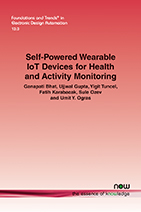Self-Powered Wearable IoT Devices for Health and Activity Monitoring
By Ganapati Bhat, Washington State University, USA, ganapati.bhat@wsu.edu | Ujjwal Gupta, Intel Corporation, USA, ujjwal.gupta@intel.com | Yigit Tuncel, University of Wisconsin-Madison, USA, tuncel@wisc.edu | Fatih Karabacak, Arizona State University, USA, fatihkarabacak@asu.edu | Sule Ozev, Arizona State University, USA, sule.ozev@asu.edu | Umit Y. Ogras, University of Wisconsin-Madison, USA, uogras@wisc.edu
Abstract
Wearable devices have the potential to transform multiple facets of human life, including healthcare, activity monitoring, and interaction with computers. However, a number of technical and adaptation challenges hinder the widespread and daily usage of wearable devices. Recent research efforts have focused on identifying these challenges and solving them such that the potential of wearable devices can be realized.
This monograph starts with a survey of the recent literature on the challenges faced by wearable devices. Then, it discusses potential solutions to each of the challenges. We start with the primary application areas that provide value to the users of wearable devices. We then present recent work on the design of physically flexible and bendable devices that aim to improve user comfort. We also discuss state-of-the-art energy harvesting and security solutions that can improve user compliance of wearable devices. Overall, this monograph aims to serve as a comprehensive resource for challenges and solutions towards self-powered wearable devices for health and activity monitoring.
Self-Powered Wearable IoT Devices for Health and Activity Monitoring
Wearable devices have the potential to transform multiple facets of human life, including healthcare, activity monitoring, and interaction with computers. At the same time, a number of technical and adaption challenges hinder widespread and daily usage of wearable devices. Recent research efforts have focused on identifying these challenges and solving them such that the potential of wearable devices can be realized.
In this monograph, the authors guide the reader through the state-of-the-art of wearable devices, detailing the challenges that researchers and designers face in achieving wide-adoption of the technology throughout society. The authors also identify the application areas where these devices are most likely to gain acceptance. They point the way to overcoming these challenges by detailing the recent advances in providing physically flexible designs, the energy management for such designs and finally consider some of the security and privacy aspects of wearable devices such that user compliance can be improved.
This monograph serves as a comprehensive resource for challenges and solutions towards self-powered wearable devices for health and activity monitoring.
